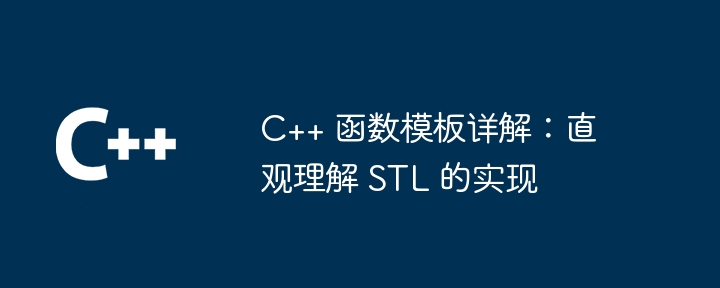Home >Backend Development >C++ >Detailed explanation of C++ function templates: intuitive understanding of STL implementation
Detailed explanation of C++ function templates: intuitive understanding of STL implementation
- WBOYWBOYWBOYWBOYWBOYWBOYWBOYWBOYWBOYWBOYWBOYWBOYWBOriginal
- 2024-04-28 09:57:011305browse
Function templates are a C mechanism that allow writing generic code to work with different types of data. It is used extensively in STL to make containers and algorithms flexible and reusable. The syntax of the function template is: template75a837cf562f69348eb0e119bf9e56d8 ReturnType FunctionName(ParameterList), where T is the type parameter, ReturnType is the function return value type, FunctionName is the function name, and ParameterList is the parameter list. Type parameters allow you to specify the function type as needed. When a template is called, the compiler instantiates a specific function for the specified type. STL containers utilize function templates to store and manipulate different types of data, such as the std::sort function that sorts elements in a range based on a specific type of sort predicate.

#Detailed explanation of C function template: intuitive understanding of STL implementation
Preface
Function template is one of the C A powerful mechanism that allows you to write general code that can be applied to different types of data. This is used extensively in the Standard Library (STL), making its containers and algorithms highly flexible and reusable.
Basic syntax of function template
template<typename T>
ReturnType FunctionName(ParameterList) { /* Function body */ }-
template75a837cf562f69348eb0e119bf9e56d8Declare that this is a function template,Tis a type parameter. -
ReturnTypeis the return type of the function. -
FunctionNameis the function name. -
ParameterListis the function parameter list.
Type Parameters
Type parameters are like variables, they allow you to specify the type of the function according to your needs. For example, the following function template can compare two values of any type:
template<typename T>
bool Compare(T a, T b) {
return a < b;
}instantiation
When you call a function template, the compiler will Instantiate a specific function. For example, to compare two int values, you would call the template function like this:
bool result = Compare<int>(5, 10);
This will generate a function named Comparebd43222e33876353aff11e13a7dc75f6 whereT has been replaced with int.
Practical case: STL container
STL containers make extensive use of function templates, allowing you to store and manipulate different types of data. Let’s take a look at a simple example:
#include <vector>
int main() {
// 创建一个存储 int 值的向量
std::vector<int> myVector;
// 使用函数模板算法对向量进行排序
std::sort(myVector.begin(), myVector.end());
return 0;
}In the above example, std::sort is a function template that sorts elements in a range based on a specific type of sort predicate. In this example, T is instantiated as int.
Conclusion
Function templates are the key to understanding STL and how it is implemented. By understanding how function templates work, you can take advantage of this powerful mechanism in C to create flexible, reusable, and efficient code.
The above is the detailed content of Detailed explanation of C++ function templates: intuitive understanding of STL implementation. For more information, please follow other related articles on the PHP Chinese website!

